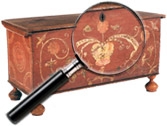Adolphe Joseph Thomas Monticelli (French, 1824 to 1886)
Monticelli attended the Ecole Municipale de Dessin in his native Marseille before entering the Ecole des Beaux-Arts in Paris, where he studied under Paul Delaroche (French, 1797 to 1856). In the 1850s he befriended the famed Barbizon artist Narcisse Diaz de la Pena (Spanish/French, 1807 to 1876), and the two men made frequent plein air painting forays into the Fontainebleau Forest. During this time Monticelli developed his unusual and distinctive style of thick impasto, textured surfaces, and layers of glazes. Soon he began to incorporate allegorical or fanciful figures into his landscapes, often bathing them in a dense golden light.
Monticelli intentionally worked in a style in which contemporary art collectors were not comfortable, and his most fervent admirers were the younger artists of Post Impressionism. Monticelli found staunch supporters in Paul Cezanne (French, 1839 to 1906), with whom he frequently traveled, Vincent van Gogh (Dutch, 1853 to 1890) and his brother Theo, who were responsible for the publication of the first book on Monticelli’s works. Van Gogh, in particular, was quite vocal in his praise of the artist, whom he considered a mentor.
Information courtesy of Neal Auction Company, June 2009.
